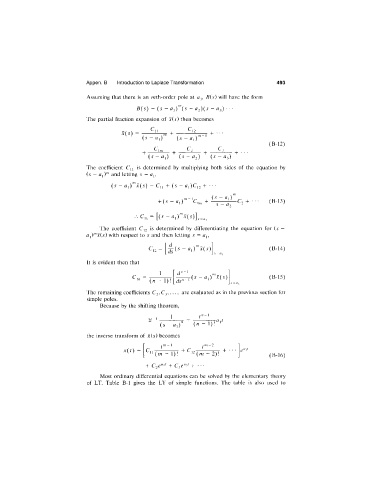Page 506 - Thomson, William Tyrrell-Theory of Vibration with Applications-Taylor _ Francis (2010)
P. 506
Appen. B Introduction to Laplace Transformation 493
Assuming that there is an mth-order pole at i/j, B{s) will have the form
- a ,) ■ ■ •
B { s ) = ( s - a ,)'"(5 - a 2 ) ( s
The partial fraction expansion of T(^) then becomes
C, C,
x{s) = +
( . - A , ) ' " ( 5 - A , ) '
(B-12)
c , c . C3
( i - A | ) ( 5 - 02) (s - a^) +
The coefficient Cj, is determined by multiplying both sides of the equation by
(<> - and letting 5 =
(5 - A , ) " ' x ( s ) = C|, + (i- - fl,)C|2 + •
^ I / ^1/ z' ’ I
^
\
{
+ s - a ^ ) ~ Ci^ + — -----:----C, + (B-13)
5 —
C|, = [(^ -
The coefficient Cj2 is determined by differentiating the equation for (s
a^y^x(s) with respect to 5 and then letting s =
^12 — ds (s - A , ) ' ” x ( i ) (B-14)
It is evident then that
U - 1
C,„ { n - 1)! ^ ( » - » 1) -'(s) (B-15)
The remaining coefficients C2, C3, ..., are evaluated as in the previous section for
simple poles.
Because by the shifting theorem,
1
aJ
i s - a , y ( « - ! ) ' '
the inverse transform of x(5) becomes
ttn — \ ^ /
x{t) C
" (m - 1)! - 2)! (B-16)
+ C2e‘’-' + Q e " ’' +
Most ordinary differential equations can be solved by the elementary theory
of LT. Table B-1 gives the LT of simple functions. The table is also used to

